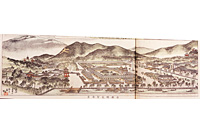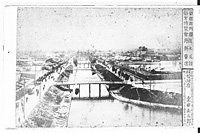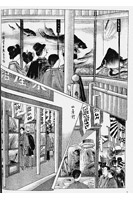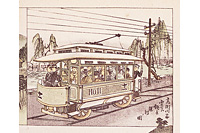Fourth National Industrial Exhibition
Kyoto's rollback operation
- Period
- : April 1, 1895 - July 31, 1895
- Venue
- : Okazaki Park of Kyoto City
- No. of visitors
- : 1,136,695
Since it was widely known that expositions would yield benefits, cities began to launch activities to win the right to host such events. The host city of the fourth National Industrial Exhibition was Kyoto, which wished to overcome its sluggish conditions generated after the transfer of the Japanese capital to Tokyo. Initially, the fourth National Industrial Exhibition was planned for 1894. However, the people of Kyoto strongly hoped that the exposition would be held in 1895 as an event commemorating the 1,100th anniversary of the establishment of Kyoto. In 1894, the Sino-Japanese War broke out, but based on the judgment that industrial promotion was important even in war time, the government decided to hold the exposition in 1895 as scheduled.
The venue was located to the south of Heian Jingu Shrine, with a total venue area of 178,000 m2, and a total structure site area of 47,000 m2. A marble fountain was constructed in front of the venue, and on both sides of the fountain was an array of shops.
The main structures were the following six: the Fine Art Building, the Industrial Building, the Agricultural and Forestry Building, the Machinery Building, the Marine Production Building, and the Animal Building. At the Machinery Building, electricity replaced coal as the power source.
In front of the Marine Production Building was the Exhibition Room of Aquatic Living Things, a facility similar to an aquarium today. At this facility, eels, carps, crucians and other fish were exhibited. Unlike a traditional display style in which visitors were able to observe fish from the top of a water tank, this facility's style was characterized by the fact that visitors were able to see the fish from the side of the water tank. However, seawater fish were not exhibited at the facility. Such fish were displayed in a fish preserve installed at Waraku-en, an amusement park in Wada Cape, Hyogo Prefecture.
At the Fine Art Building, Seiki Kuroda, a Japanese artist who had returned from France, exhibited a nude with the title of Chosho (Make up in the morning), (which was subsequently destroyed in a fire), arousing great controversy regarding the disturbance of public morals. Eventually, it was decided to continue the display of the picture on the condition that a part of the picture would be covered with a cloth. This controversy was featured in a cartoon by G. Bigot.
Another main feature of the exposition was that a streetcar was operated outside the venue as an official means of public transportation for the first time in Japan. The streetcar ran from Shichijo, Kyoto, to the area around the venue near Heian Jingu Shrine, and also to the vicinity of Lake Biwa Canal. Running southward to Fushimi, the electricity for the streetcar was powered by the water from the canal. It can be said that it served as a symbol of the coming of the electricity period.
Although the exposition was somewhat controversial, it came to a highly successful end, drawing 169,098 items from 73,781 exhibitors, as well as welcoming 1,136,695 visitors. For the event, streets and accommodation were improved, providing the basis for Kyoto's establishment as a sightseeing destination.
- References:
Kuni, Takeyuki.: Hakurankai no jidai: Meiji seihu no hakurankai seisaku (Iwata shoin, 2005) <D7-H68>
Yoshida, Mitsukuni (ed).: Zusetsu bankoku hakurankaishi: 1851-1942 (Shibunkaku shuppan, 1985) <D7-66>





